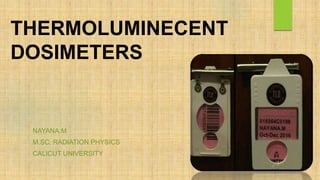
Measuring radiation exposure with thermoluminescent dosimeters (TLDs
- 2. INTRODUCTION As per the radiation protection rules , radiation monitoring become necessary for person , patient ,public. Dosimetry is the monitoring of individuals to accurately determine their radiation dose equivalent at work sites. When radiation interacts with the human body, there are no perceptible sensations and usually no immediate effects. To protect ourselves and others, we must use and rely upon instruments to quantify and qualify radiation measurements .That is to ensure dose limits are not exceeded 20 mSv /y for whole body and to confirm that doses are As Low As Reasonably Achievable.
- 3. THERMOLUMINESCENT DOSIMETER, TLD Thermoluminesecence is the glowing property of some materials when get heated.. A thermoluminescent dosimeter, or TLD, is a type of personnel radiation dosimeter. It measures ionizing radiation exposure by measuring the intensity of visible light emitted from a crystal in the detector when the crystal is heated. The amount of light emitted is dependent upon the radiation exposure Measures radiation ranges from 10mR- 10000R with accuracy of +/- 10%
- 4. Theory of thermoluminescent dosimetry:-
- 5. Heating causes e- to drop back to valence band, releasing a photon of energy equivalent to energy difference between trap state and ground state. If it take long time to drop back then it is called FADING. It is a property that is dependent on incident energy and intrinsic property of TLD material.
- 6. Glow Curves - Plot of thermoluminescence against temperature is called Glow curve. - As the temperature of TL material exposed to radiation is increased the probability of releasing e- increases. - Optimum Temperature for TLD readout is 170-230oc - Area under this curve is directly proportional to the amount of radiation that was absorbed in the chip. - The individual glow peaks are numbered and correspond to different trap depths. .
- 8. TL MATERIALS o The materials are usually inorganic crystalline or polycrystalline crystals or phosphors which have defects produced during synthesis including those due to impurities added intentionally. o The most commonly used TL phosphors are: olithium fluoride ocalcium fluoride olithium borate ocalcium sulphate. o In India CaSO4:Dy(1:3) embedded Teflon TLD disk are used. o It should have a single glow curve.
- 9. Characteristics of CaSO4:Dy - Effective Atomic No- 15. - Main Peak at 200oC - Emission Maximum 480-570 nm - Fading less than 5 % per month(at 25oC ) - Self fading 0.01 mSv/month - Linearity in Response :linear upto 30 Gy - Colour of emitted light :yellowish -white
- 10. To measure X, , - radiation
- 11. TLD READER CONSTRUCTION - Irradiated material is placed in heater cup or planchet and heated . - Emitted light is measured by photomultiplier tube converts light into electrical energy. current is then amplified and measured by recorder
- 13. POSITIONING OF THE BADGE -One badge should be worn at chest level to record whole body equivalent dose. - Should be worn below the lead apron if used. -If selectively high doses are expected to hands and head- additional wrist and head badges may be used.
- 14. ADVANTAGES ◦ Able to measure a greater range of doses (better sensitivity) ◦ Doses can be easily obtained ◦ Linearity of dose response ◦ Energy independence. ◦ Quicker turn around time for readout ◦ Reusable ◦ Small size -So effective in point dose measurement. ◦ Less expensive.
- 15. DISADVANTAGES Lack of uniformity – batch calibration needed Light sensitivity Fading No permanent record Dust on the detector will glow when heated and will be recorded by the phototube as a false reading.
- 17. Conclusion Use of TLD is necessary at radiation working environment It only measures the dose doesn’t provide any protection to personnels. A TLD of one can’t be used by other.